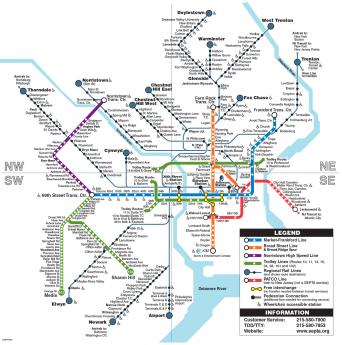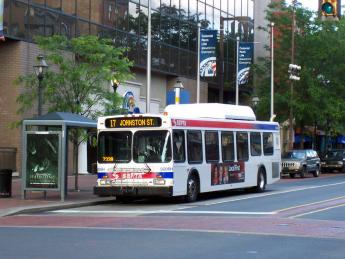Related Topics
Right Angle Club: 2015
The tenth year of this annal, the ninety-third for the club. Because its author spent much of the past year on health economics, a summary of this topic takes up a third of this volume. The 1980 book now sells on Amazon for three times its original price, so be warned.
Septa's Brain Center

|
| Septa System Map |
The Right Angle Club was recently introduced to two important examples of the Philadelphia Scene. The old spirit we used to have so much of, capsulized by the expression, "Pick up the ball -- and run with it!". It was very heartening to behold.
First of all, the speaker was the director of Radnor Associates 21, a volunteer company making documentary films. Its headquarters is in Wayne, across the street from the movie theater, in rather cramped quarters and a budget of $250,000 a year. Mostly run by volunteers and veterans of the old radio era of Philadelphia, they took it in their head it would be fun to make a video of the SEPTA nerve center, at 12th and Market. It's really pretty neat, with cuts and splices, telling the story of something most Philadelphians never dreamed existed. After all, the automobile revolution pretty well destroyed the old Philadelphia of trolleys and buses, subways and elevations. Most people just drive to work oblivious to public transportation, vaguely aware blue-collar Philadelphia has a network. One of the newer elements of the network is the high-speed line to New Jersey, which itself is thirty or forty years old. It takes twelve minutes to get from Haddonfield to Center City, so I take it, and thus had become vaguely conscious that SEPTA had greatly improved in the last couple of years. Everybody's polite and jolly, the trains and buses are new. And everything seems to run frequently, and on time.
In the legal community, there is a piece of the interesting history of SEPTA. It was one of three parts of the old Penn Central, composed of freight, long-distance rail, and commuter rail. In turn, this was a conglomeration of trolley companies, bus lines, freight, and long-distance rail companies. However mighty the old Pennsy might have been, it collapsed and consolidated, and then split into three parts. Only the freight lines really made much money and wanted to be set free of the national politics of intercity rail, the local politics of commuter rail, the union domination, and the whole image of "corrupt and contented". Well, the Conrail freight division is making a fortune hauling shale oil around, Amtrak is struggling to get subsidies from Congress. Where in the world is SEPTA, the commuter complex which always lost a lot of money?
Well, it has headquarters somewhere, and union dealings, and politics. But the engineering center is at 12th and Market, pretty much dominating the 13th Street exit of the Market Street subway, and the underground extensions of the tunnel connecting the Pennsylvania and Reading commuter lines. Nobody much goes there, except for the fact it is crowded with people, going somewhere.

|
| Septa Market Street |
Well, the director of Radnor got the idea of making a video of it, and if you get the chance to see it, it's quite remarkable as a film. More important than that, it shows someone got the idea of unifying the highly diversified hundreds of buses, trolleys, and trains in a nerve center. Every single driver of one of those vehicles is in video communication with headquarters, every one of those vehicles is tracked on GPM, every single switch in the system is controlled by a central operator. They watch to see how the weather is, where the crowds are, what the speed of the vehicle is, whether it's on time or not. And whether something needs to be re-routed somewhere to meet the rush, or the accident, or the weather. Not only whether a train is on time, but what its on-time record has been. Whether the vehicles and stations are clean, whether there's a hold-up somewhere. No doubt, they can tell whether someone is sick, needs an ambulance, and so on.
Now, this is SEPTA. I expected to see grumpy old union functionaries, growling at people. Instead, I saw the happiest group of blue-collar workers you can imagine, shouting out they have the best job in the whole world. Exciting and worth-while. There are lots of problems, so, great. More challenge, more variety. These are people working at all hours, and working hard. Happy. And the trains are clean and run on time. They are safer. Who cares what they do in St. Louis, or Tokyo, or Paris -- we aren't competing with them, and we wish them well. This is Philadelphia, and these people are running with the ball. Including the director of the Radnor studios, who decided, on his own, to give them a pat on the back. That's part of the spirit, too.
Originally published: Saturday, August 08, 2015; most-recently modified: Wednesday, June 05, 2019